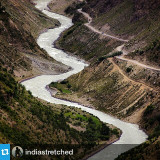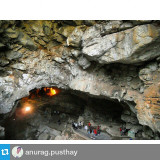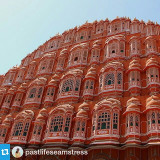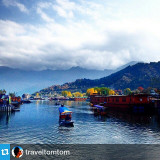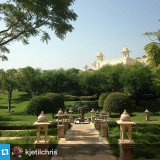Random image from our India photo collection
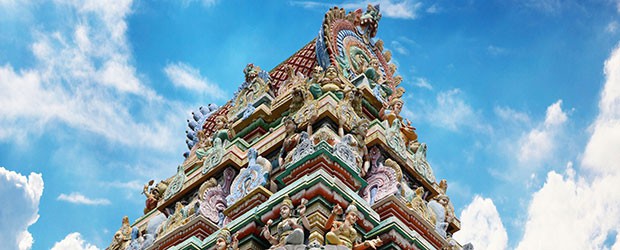
Delhi
Tourist Centers
The forts are the best way to know about the glorious heritage of Delhi. The monuments also help us travel back through time into centuries of history, filled with the rise and fall of dynasties that ruled this land. These monuments are present right from Wazirabad in the north to the Qutab and beyond in the south of Delhi.
Indraprashtha was the most flourishing city and the capital of the Pandavas, with gigantic forts and magnificent palaces. Excavations at the Purana Qila, identified at the site of Indraprashtha, have yielded proofs of the site having remained under continuous occupation up to 1000 BC. The Mauryas, Sungas, Kushans, Guptas, Rajputs, and Mughals held it under their sway. With the decline of Buddhism, Delhi became unknown and for centuries remained an unimportant addition of great modern cities like Mathura and Kannauj.
We hear of Delhi again, after countless centuries, when the Tomar Rajputs came to power, first settled at Indraprashtha before moving to the rocky terrain beyond Tughlaqabad. Tomar history is verifiable. The water tank called Surajkund, ruins of fortifications, and a bund can still be visited at the stone-strewn site, as puzzling as the Stonehenge.
When the Tomars shifted to Mehrauli in the eleventh century and Anang Pal II built a formidable fort to ward off the growing fear of invasions, Delhi got Lal Kot, the first fort strengthened with magnificent walls and numerous gates. The Chauhan Rajputs defeated the Tomar and occupied Lal Kot.
Qila Rai Pithora, the second fort of Delhi. With huge walls, 10 feet in width at places, this fort had numerous gates, some of which can still be identified as giant gaps in the long stretching walls. Hauz Rani and Budayuni Gates were two most prominent gates. At Budayuni Gate, the guilty were tortured and beheaded in full public view. Ranjit Gate on the northern ramparts was the grandest but weakest gate. The Turks entered Lal Kot through this gate and immediately re-strengthened it to prevent a recurrence of invasion. Ruins of Rajput and Mamluk palaces can be seen behind Balban’s tomb near the Qutab Minar.
In 1303, the Mongols under Taraghai plundered Delhi and almost captured it when, quite inexplicably, they rushed back.
Delhi’s third fort was built by Alauddin Khilji who decided to build a defense fortress at Siri with strong battlement ramparts and impregnable bastions. It was never attacked by enemies, but destroyed by succeeding rulers who used it for free building material for their forts. Only some portions of the Siri walls can be seen today, all else has been destroyed and stones removed. When Ghazi Malik founded the Tughlaq Dynasty in 1321, he built the strongest fort in Delhi at Tughlaqabad, completed with great speed within four years of his rule. Tughlaqabad is Delhi’s most gigantic and awesome fort, even in its ruined state. Within its huge and magnificent walls, double-storied bastions, and gigantic towers were housed grand palaces, wonderful mosques, and audience halls.
Muhammad-bin-Tughlaq, who was accused, of murdering his sire built Adilabad and Nai-ka-Kot, the two small fortresses which are adjacent to the Tughlaqabad fort.
Adilabad, the fourth fort of Delhi, contained a grand palace of thousand pillars and splendid halls. Later he also brought in the cities lying between Siri, Tughlaqabad, and the Qutab and called it Jahanpanah. Ruins of gigantic ramparts of his two fortresses and some portions of the Jahanpanah walls have survived through times of destruction.
A small portion of the Jahanpanah watchtower Vijai Mandal still stands in ruins, dominating the landscape.
Ferozshah, Muhammad Tughlaq’s successor, built his new city northward on the banks of Yamuna. Kotla was the inner bastion of Ferozabad, built like Windsor. It had great palaces and a magnificent mosque that inspired Timur’s greed. Destroyed by the Mughals, Kotla palaces were reduced to mere ruins. One can still see the pyramidal structure topped by the Ashokan Pillar brought from Topra (near Ambala), ruins of the mosque, and a three-tiered baoli. Ferozabad stretched from Wazirabad to Qutab with countless schools and mosques in between. Timur’s invasion of Delhi in 1398 reduced the city to ruins. He took away with him elephants loaded with treasures and costly building material, artists, masons and skilled workers as prisoners. The Saiyyads and Lodis used Kotla as their fort. In fact, the Lodis had moved the capital to Agra, and Delhi once again became unimportant.
The Mongols in 1526 led by Zahir-ud-din Babur vanquished the Lodis to establish the Mughal Empire. Babur chose Agra as his capital but his successor decided in favor of Delhi. His city Dinpanah was built on the site of Indraprashtha. Dinpanah was the sixth fort of Delhi. Within five years, massive gateways and lofty ramparts were completed but unfortunately, Humayun lost his kingdom to the Afghan chieftain Shershah, who destroyed much of Humayun’s buildings in the fort. He called his city Shergarh. Two gateways of his city, Lal Darwaza and Khooni Darwaza, can still be seen in their original magnificence. Within the fort, Shershah built a grand mosque and an octagonal tower called Sher Mandal. When Humayun regained his kingdom with Persian help, he hardly built any new structures. Humayun fell down from the roof of Sher Mandal. Humayun knelt down to pray when his foot got entangled in the dress and he tumbled down the steps, fatally injuring himself and then dying within three days. This was the end of the Mughal emperor. Akbar went back to Agra. Jahangir and Shahjahan also made architectural contributions to the Agra fort.
In 1639, Shahjahan decided to shift his capital to Delhi. Within eight years, Shahjahanabad was completed with the Red Fort—Qila-i-Mubarak (fortunate citadel), Delhi’s seventh fort, ready in all its magnificence to receive Shahjahan. Much changed because of large-scale demolitions during the British occupation of the fort, but its important structures have survived. The glory faded with age but is still impressive. The Chatta Chowk and the Naubat Khana was a double-storied structure where court musicians played five times a day. Here is the fabulously crafted baldachino—the marble canopy decorated with the most exquisite pietra dura work. Here also was the Diwan-i-Aam which witnessed unexcelled splendor when it used to be decorated with golden curtains, gorgeous carpets, and gold and silver railings below dazzling chandeliers.
Behind the Diwan-i-Aam are the Zenana quarters with such grand palaces as the Rang Mahal and Mumtaz Mahal. The marble lotus, a fountain in the center of Rang Mahal, carved out of a single slab, is a piece of sheer beauty. In its sculptured grandeur, the lotus is matched only by the grille walls under the scales of justice in the Khwab Gah. The pavilion in white marble (Diwan-i-Khas) has lost much of its splendor. Here, under its original silver ceiling, stood the world famous Peacock Throne studded with the costliest gems of the Mughal Empire costing nearly 12,637,500 sterling as per contemporary accounts. On the ceiling slab is inscribed the line, ‘If there is a paradise on the face of the earth, it is here, it is here, it is here’. Nadir Shah, Ahmad Shah Abdali, Ghulam Qadir, the Marathas, and finally the British looted and plundered the Mughal treasures and destroyed many structures of immense beauty. The gardens of Mahtab Bagh and Hayat Baksh have vanished. A later-day pavilion in red sandstone stands at the center of a dried up pool. It was built by Bahadur Shah II.
Moti Masjid, the mosque built by Aurangzeb, is a gem of architecture despite the sickly marble of the new domes—original copper casing having been removed long back.
The Fort still retains some of its lost glory. It is the only fort with some well-preserved royal structures to give an idea of the glory of the Mughal Empire. The Red Fort was the last fort built in Delhi and it witnessed the fortune, the splendor and the fall of the Mughals, British rule, and finally the dawn of Indian Independence.
Go back
Indraprashtha was the most flourishing city and the capital of the Pandavas, with gigantic forts and magnificent palaces. Excavations at the Purana Qila, identified at the site of Indraprashtha, have yielded proofs of the site having remained under continuous occupation up to 1000 BC. The Mauryas, Sungas, Kushans, Guptas, Rajputs, and Mughals held it under their sway. With the decline of Buddhism, Delhi became unknown and for centuries remained an unimportant addition of great modern cities like Mathura and Kannauj.
We hear of Delhi again, after countless centuries, when the Tomar Rajputs came to power, first settled at Indraprashtha before moving to the rocky terrain beyond Tughlaqabad. Tomar history is verifiable. The water tank called Surajkund, ruins of fortifications, and a bund can still be visited at the stone-strewn site, as puzzling as the Stonehenge.
When the Tomars shifted to Mehrauli in the eleventh century and Anang Pal II built a formidable fort to ward off the growing fear of invasions, Delhi got Lal Kot, the first fort strengthened with magnificent walls and numerous gates. The Chauhan Rajputs defeated the Tomar and occupied Lal Kot.
Qila Rai Pithora, the second fort of Delhi. With huge walls, 10 feet in width at places, this fort had numerous gates, some of which can still be identified as giant gaps in the long stretching walls. Hauz Rani and Budayuni Gates were two most prominent gates. At Budayuni Gate, the guilty were tortured and beheaded in full public view. Ranjit Gate on the northern ramparts was the grandest but weakest gate. The Turks entered Lal Kot through this gate and immediately re-strengthened it to prevent a recurrence of invasion. Ruins of Rajput and Mamluk palaces can be seen behind Balban’s tomb near the Qutab Minar.
In 1303, the Mongols under Taraghai plundered Delhi and almost captured it when, quite inexplicably, they rushed back.
Delhi’s third fort was built by Alauddin Khilji who decided to build a defense fortress at Siri with strong battlement ramparts and impregnable bastions. It was never attacked by enemies, but destroyed by succeeding rulers who used it for free building material for their forts. Only some portions of the Siri walls can be seen today, all else has been destroyed and stones removed. When Ghazi Malik founded the Tughlaq Dynasty in 1321, he built the strongest fort in Delhi at Tughlaqabad, completed with great speed within four years of his rule. Tughlaqabad is Delhi’s most gigantic and awesome fort, even in its ruined state. Within its huge and magnificent walls, double-storied bastions, and gigantic towers were housed grand palaces, wonderful mosques, and audience halls.
Muhammad-bin-Tughlaq, who was accused, of murdering his sire built Adilabad and Nai-ka-Kot, the two small fortresses which are adjacent to the Tughlaqabad fort.
Adilabad, the fourth fort of Delhi, contained a grand palace of thousand pillars and splendid halls. Later he also brought in the cities lying between Siri, Tughlaqabad, and the Qutab and called it Jahanpanah. Ruins of gigantic ramparts of his two fortresses and some portions of the Jahanpanah walls have survived through times of destruction.
A small portion of the Jahanpanah watchtower Vijai Mandal still stands in ruins, dominating the landscape.
Ferozshah, Muhammad Tughlaq’s successor, built his new city northward on the banks of Yamuna. Kotla was the inner bastion of Ferozabad, built like Windsor. It had great palaces and a magnificent mosque that inspired Timur’s greed. Destroyed by the Mughals, Kotla palaces were reduced to mere ruins. One can still see the pyramidal structure topped by the Ashokan Pillar brought from Topra (near Ambala), ruins of the mosque, and a three-tiered baoli. Ferozabad stretched from Wazirabad to Qutab with countless schools and mosques in between. Timur’s invasion of Delhi in 1398 reduced the city to ruins. He took away with him elephants loaded with treasures and costly building material, artists, masons and skilled workers as prisoners. The Saiyyads and Lodis used Kotla as their fort. In fact, the Lodis had moved the capital to Agra, and Delhi once again became unimportant.
The Mongols in 1526 led by Zahir-ud-din Babur vanquished the Lodis to establish the Mughal Empire. Babur chose Agra as his capital but his successor decided in favor of Delhi. His city Dinpanah was built on the site of Indraprashtha. Dinpanah was the sixth fort of Delhi. Within five years, massive gateways and lofty ramparts were completed but unfortunately, Humayun lost his kingdom to the Afghan chieftain Shershah, who destroyed much of Humayun’s buildings in the fort. He called his city Shergarh. Two gateways of his city, Lal Darwaza and Khooni Darwaza, can still be seen in their original magnificence. Within the fort, Shershah built a grand mosque and an octagonal tower called Sher Mandal. When Humayun regained his kingdom with Persian help, he hardly built any new structures. Humayun fell down from the roof of Sher Mandal. Humayun knelt down to pray when his foot got entangled in the dress and he tumbled down the steps, fatally injuring himself and then dying within three days. This was the end of the Mughal emperor. Akbar went back to Agra. Jahangir and Shahjahan also made architectural contributions to the Agra fort.
In 1639, Shahjahan decided to shift his capital to Delhi. Within eight years, Shahjahanabad was completed with the Red Fort—Qila-i-Mubarak (fortunate citadel), Delhi’s seventh fort, ready in all its magnificence to receive Shahjahan. Much changed because of large-scale demolitions during the British occupation of the fort, but its important structures have survived. The glory faded with age but is still impressive. The Chatta Chowk and the Naubat Khana was a double-storied structure where court musicians played five times a day. Here is the fabulously crafted baldachino—the marble canopy decorated with the most exquisite pietra dura work. Here also was the Diwan-i-Aam which witnessed unexcelled splendor when it used to be decorated with golden curtains, gorgeous carpets, and gold and silver railings below dazzling chandeliers.
Behind the Diwan-i-Aam are the Zenana quarters with such grand palaces as the Rang Mahal and Mumtaz Mahal. The marble lotus, a fountain in the center of Rang Mahal, carved out of a single slab, is a piece of sheer beauty. In its sculptured grandeur, the lotus is matched only by the grille walls under the scales of justice in the Khwab Gah. The pavilion in white marble (Diwan-i-Khas) has lost much of its splendor. Here, under its original silver ceiling, stood the world famous Peacock Throne studded with the costliest gems of the Mughal Empire costing nearly 12,637,500 sterling as per contemporary accounts. On the ceiling slab is inscribed the line, ‘If there is a paradise on the face of the earth, it is here, it is here, it is here’. Nadir Shah, Ahmad Shah Abdali, Ghulam Qadir, the Marathas, and finally the British looted and plundered the Mughal treasures and destroyed many structures of immense beauty. The gardens of Mahtab Bagh and Hayat Baksh have vanished. A later-day pavilion in red sandstone stands at the center of a dried up pool. It was built by Bahadur Shah II.
Moti Masjid, the mosque built by Aurangzeb, is a gem of architecture despite the sickly marble of the new domes—original copper casing having been removed long back.
The Fort still retains some of its lost glory. It is the only fort with some well-preserved royal structures to give an idea of the glory of the Mughal Empire. The Red Fort was the last fort built in Delhi and it witnessed the fortune, the splendor and the fall of the Mughals, British rule, and finally the dawn of Indian Independence.
Go back


